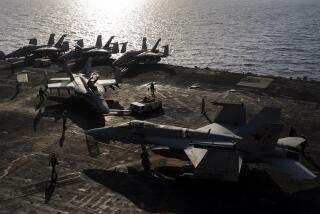First U.S. Warship to Be Sunk in World War II : New Reuben James Stirs Tales of the Old
Four decades--and more--have passed since the destroyer Reuben James was torpedoed and sunk off Iceland. But Dan Del Grosso hasn’t forgotten.
“A ship,” he said, “is nothing but a hole in the water, lined with steel, into which you pour sweat. Ask any old Navy man. They’ll all say the same. But that wasn’t true of the Reuben James--she was different. She was alive, the old Rube. . . .”
Del Grosso ought to know.
He was a pink-cheeked seaman first class serving in her the night she was sunk, one of just 45 men who survived. And on Saturday, he was one of 11 survivors from the ship who came to Long Beach Naval Station as honored guests at the commissioning of a brand-new guided missile frigate, formally designated FFG 57--and named Reuben James.
“Don’t look much like the old Rube,” Del Grosso commented. “But she’ll do.”
His old shipmates, seated together to watch the ceremonies, grunted agreement.
It was a warm spring day, and a Navy band kept the air moving with renditions of traditional Navy anthems--”Anchors Aweigh” and “Eternal Father” were favorites--while brass from the Naval Sea Systems Command, Surface Squadron One, the federal Department of Energy and the Todd Shipyards (where the new frigate was built) helped the temperature rise.
But the men from the first Reuben James only half-listened to the speeches.
“She was named after a hero from the Barbary Wars, you know,” R.J. Carr, sometime fireman second class, told a young listener. “He kept his officer, Lt. Stephen Decatur--who became a famous hero himself--from being killed by a Barbary pirate. Risked his life to take a cutlass stroke.
“Odd, when you think of it. The old Rube died doing something like that, too. . . .”
On Oct. 31, 1941, the Reuben James, a relic of World War I revived and recommissioned for “neutrality patrol” (a legalistic cover for America’s covert support of Britain without a declaration of war), was escorting a convoy of freighters and tankers off Iceland when she was hit by a torpedo. Her magazine exploded and she went down like a rock, becoming the first U.S. naval vessel sunk in World War II--five weeks before Pearl Harbor.
“No chance at all the Germans fired that torpedo at the Reuben James,” Carr said. “It was aimed at one of the freighters or tankers--they’d never waste a fish on a tin can like the old Rube. She took a blow that was aimed at someone else . . . just like her namesake!”
Onetime Chief Machinist Mate Bill Bergstrasse shrugged philosophically.
“Don’t matter,” he said. “She got it. I had just come off watch, out of the engine room, and that is why I’m alive, I guess. I was aft--and then, I was in the water. I know I got picked up pretty quick. It would of had to be quick. The water was so cold it would kill you in no time. But it didn’t seem quick. It seemed like a long time.”
Samuel Orme, nearby and listening, grinned sourly. A retired navy captain, he was a young ensign on the destroyer Niblack that night, and was one of the men who jumped into the sea to help rescue the men of the Reuben James.
“We got them out of the water as fast as we could,” he said. “For a long time we thought just 44 had survived, from the 147 who were on board. Later, it turned out another man had been rescued--and got lost in the shuffle. Things were kind of confusing that night.”
Former Machinist Mate Second Class--and survivor--Guy Graham also recalled Orme’s part that day. “Which is why we made a point of inviting him to Reuben James reunions, and to this commissioning. A man who will go into a freezing sea for you sure can’t be an enemy; we want to keep him around!”
George F. Giehrl, who was a Fireman Second Class sleeping in an aft compartment when the James was torpedoed, agreed with that. “We started having reunions in 1983,” he said. “Of the 45 who lived through the sinking, six have died and another 24 have simply faded out of sight somewhere.
“But when John Kieley--that’s Cmdr. Kieley, captain of this new ship--came to the one last year and then invited us to the commissioning, we wanted to get as many old friends and shipmates as we could. And now we’re here. All that’s left of the Rube.
“This new ship’s great--10, maybe 20 times the punch of the old Rube, and twice as fast. But the guys who serve in this new ship are a lot like we were--peacetime kids, looking for something better than sweeping up a store. You can’t help wondering how they feel about her.”
Not far away, an older woman was talking to a fresh-faced sailor whose job it was to guide visitors around the ship and answer questions.
“And are you stationed ashore, young man?” she asked.
“No ma’am,” he replied. “I’m deck division. Here. In this ship. In the Rube. . . .”
More to Read
Sign up for Essential California
The most important California stories and recommendations in your inbox every morning.
You may occasionally receive promotional content from the Los Angeles Times.










